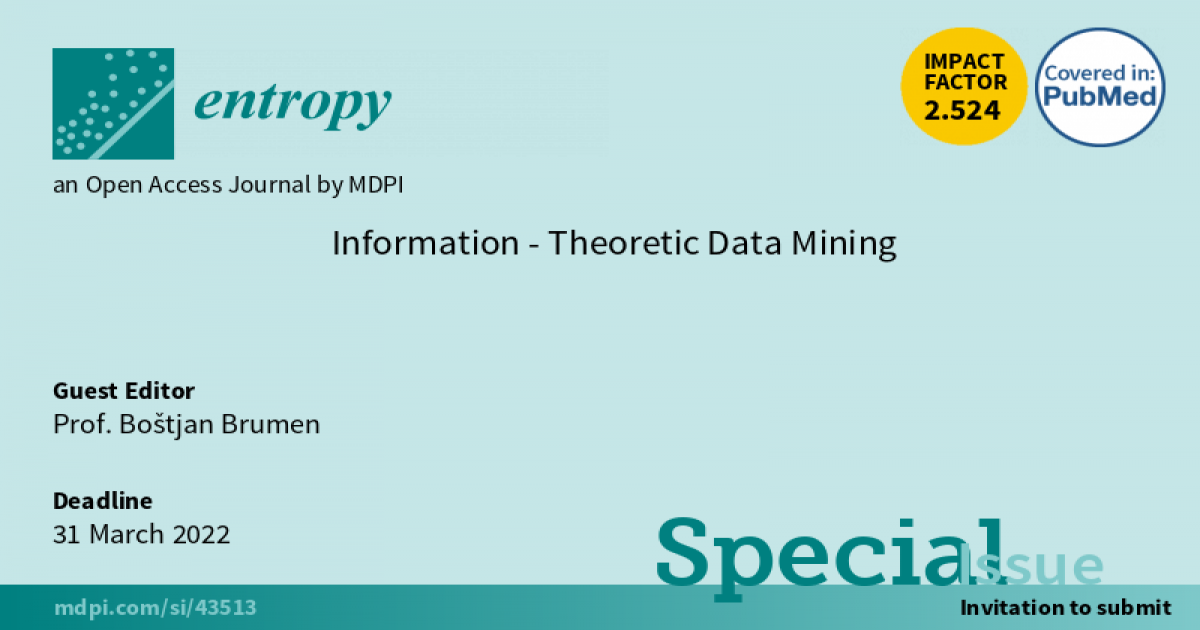Information-Theoretic Data Mining
A special issue of Entropy (ISSN 1099-4300). This special issue belongs to the section "Multidisciplinary Applications".
Deadline for manuscript submissions: closed (31 March 2022) | Viewed by 52530

Special Issue Editor
Special Issue Information
Dear Colleagues,
Predictions are difficult, especially those about the future. Data mining is the process of converting data to knowledge using methods at the crossroads of machine learning, artificial intelligence, statistics, and database systems. Data science and data engineering help create knowledge in various forms of models, which in turn are used to finding anomalies, patterns, and correlations within large amounts of data to help predict the future or explain the present.
Currently, data mining is implemented on large scales to help solve business and societal problems. Information-theoretic data mining plays a special role due to its solid foundations in information theory. The field is slowly maturing with contributions from many fields of information and computer science and related sciences. This interdisciplinary characteristic leads to different viewpoints, different implementations, and different approaches.
Therefore, contributions are being solicited to this Special Issue on the many faces of information theory in data mining, presenting both theoretical and practical aspects of developing and using data mining approaches.
Prof. Boštjan Brumen
Guest Editor
Manuscript Submission Information
Manuscripts should be submitted online at www.mdpi.com by registering and logging in to this website. Once you are registered, click here to go to the submission form. Manuscripts can be submitted until the deadline. All submissions that pass pre-check are peer-reviewed. Accepted papers will be published continuously in the journal (as soon as accepted) and will be listed together on the special issue website. Research articles, review articles as well as short communications are invited. For planned papers, a title and short abstract (about 250 words) can be sent to the Editorial Office for assessment.
Submitted manuscripts should not have been published previously, nor be under consideration for publication elsewhere (except conference proceedings papers). All manuscripts are thoroughly refereed through a single-blind peer-review process. A guide for authors and other relevant information for submission of manuscripts is available on the Instructions for Authors page. Entropy is an international peer-reviewed open access monthly journal published by MDPI.
Please visit the Instructions for Authors page before submitting a manuscript. The Article Processing Charge (APC) for publication in this open access journal is 2600 CHF (Swiss Francs). Submitted papers should be well formatted and use good English. Authors may use MDPI's English editing service prior to publication or during author revisions.
Keywords
- data mining
- data engineering
- big data
- data science
- machine learning
- artificial intelligence
- knowledge extraction
- information theory
Benefits of Publishing in a Special Issue
- Ease of navigation: Grouping papers by topic helps scholars navigate broad scope journals more efficiently.
- Greater discoverability: Special Issues support the reach and impact of scientific research. Articles in Special Issues are more discoverable and cited more frequently.
- Expansion of research network: Special Issues facilitate connections among authors, fostering scientific collaborations.
- External promotion: Articles in Special Issues are often promoted through the journal's social media, increasing their visibility.
- Reprint: MDPI Books provides the opportunity to republish successful Special Issues in book format, both online and in print.
Further information on MDPI's Special Issue policies can be found here.






